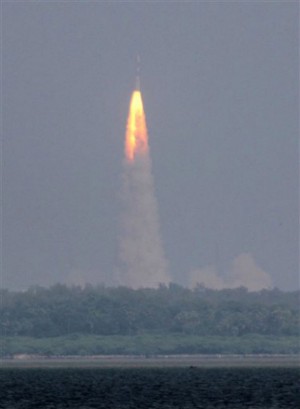India directs spacecraft toward Martian orbit

In this Nov. 5, 2013 file photo, the Polar Satellite Launch Vehicle (PSLV-C25) rocket lifts off carrying India’s Mars spacecraft from the east-coast island of Sriharikota, India. With home-grown technology and a remarkably low budget of about $75 million, India could become the first nation to conduct a successful Mars mission on its first try. If the Mars Orbiter Mission, or MOM, settles into orbit in the morning Wednesday, Sept. 24, 2014, as planned, the country will join the U.S., European Space Agency and the former Soviet Union in the elite club of Martian explorers. AP
NEW DELHI — An Indian spacecraft was nearing its final destination in orbit around Mars on Wednesday, with scientists hoping a success will launch the nation into an elite club of deep-space explorers.
If the Mars Orbiter Mission, affectionately nicknamed MOM, takes its position around the red planet, India will join the U.S., the European Space Agency and the former Soviet Union in the elite club of Martian explorers.
Scientists with the Indian Space and Research Organization have uploaded commands to slow the craft and maneuver it by burning engines for about 24 minutes before it drops into its designated orbit.
Success would mark a milestone for India’s space program in showing the world that it’s capable of complex missions and could reliably act as a launching pad for commercial, navigational and research satellites.
“We have to excel,” space agency chief K. Radhakrishnan said on Tuesday.
Succeeding would also mark a major feat for the developing country of 1.2 billion people, most of whom are poor. At the same time, India has a robust scientific and technical educational system that has produced millions of software programmers, engineers and doctors, catapulting many into the middle class.
More than half the world’s previous attempts — 23 out of 41 missions — have failed, including one by Japan in 1999. The United States had its first success with a 1964 flyby by a spacecraft called Mariner 4, returning 21 images of the surface of the planet. The former Soviet Union reached the planet in 1971, and the European Space Agency in 2003.
Indian Prime Minister Narendra Modi was at the agency’s command center in the southern city of Bangalore to witness the satellite move into orbit.
The 1,350-kilogram (nearly 3,000-pound) orbiter would join NASA’s Mars Atmosphere and Volatile Evolution mission, or Maven, which reached its position around the red planet on Sunday at a cost of $671 million — nearly 10 times MOM’s cost.
Maven’s chief investigator, Bruce Jakosky of the University of Colorado, said the U.S. team was rooting for the Indian mission. “We’re sending them the best wishes from the entire Maven team,” he said Monday.
There are three more satellites already circling the planet — NASA’s Mars Reconnaissance Orbiter and Mars Odyssey, and the ESA’s Mars Express. On the Martian surface, NASA’s Curiosity and Opportunity rovers are rolling across rocky terrain.
India has said the spacecraft — also called Mangalyaan, meaning “Mars craft” in Hindi — is chiefly meant to showcase the country’s ability to design, plan, manage and operate a deep-space mission. India has already conducted dozens of successful satellite launches, including sending up the Chandrayaan-1 lunar orbiter, which discovered key evidence of water on the Moon in 2008.
If MOM successfully reaches orbit, it is expected to circle for at least six months on an elliptical path that gets within 365 kilometers (227 miles) of the planet’s surface at its closest and 80,000 kilometers (49,700 miles) at its farthest.
Five solar-powered instruments would gather data that will help determine how Martian weather systems work and what happened to the water that is believed to have once existed on Mars in large quantities. It also will search Mars for methane, a key chemical in life processes on Earth that could also come from geological processes.
None of the instruments will send back enough data to answer these questions definitively, but experts say the data will help them better understand how planets form, what conditions might make life possible and where else in the universe it might exist.
RELATED STORY